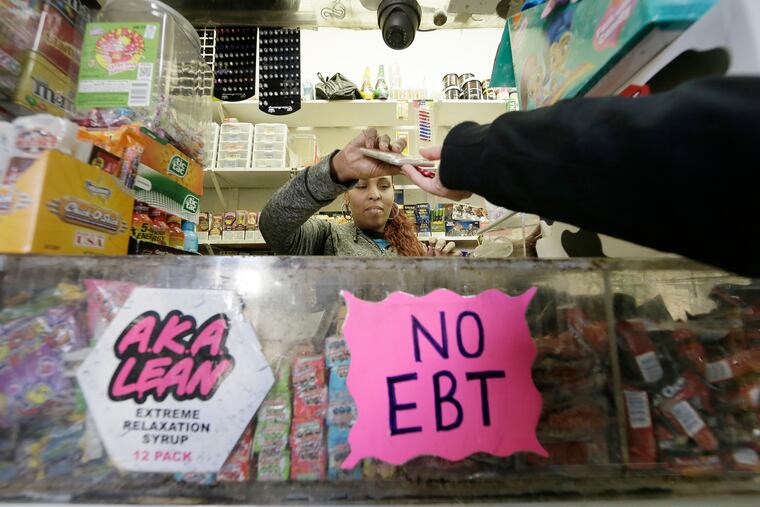Phones are banned at Kensington High School. So kids pay to stash them at corner stores. | Ronnie Polaneczky
The irony is that the phone ban meant to help kids be safe inside the school forces them to scour the sketchy neighborhood for places to stash the phones they need to be safe outside, too.

Thanks to a shortsighted school policy, Octavio Rodriguez Sr. pays two bills a month for his son's Galaxy cell phone: one to Sprint and the other to a corner deli near Kensington High School where his son stashes his phone while he's in school.
Octavio Jr. is a sophomore at Kensington High, whose 598 students are forbidden to take phones into the building. So the kids have to figure out where to "store" their phones before they get to school at Cumberland and Amber Streets.
"For a while Octavio was hiding his phone in bushes or inside burned-out cars" the way drug dealers hide their cache, says Rodriguez. "The situation was encouraging kids to be sneaky. I told Octavio, 'You need a better alternative.' "
He found one at nearby Yum Yum Deli. For 50 cents a day, he and other students deposit their phones there in the morning and are given numbered receipts – like the kind you get from a coat-check operation – to retrieve them at day's end.
"In September, a few students asked if we can take their phones," says Yum Yum clerk Wendy Ni, who at first held them for free. But as word spread and almost 100 kids crowded the tiny shop, things got chaotic. After Yum Yum instituted the fee, the number of phones dropped to a manageable 25 a day.
Problem solved — but not for impoverished families, of which this city has a lot. Proving, once again, that it takes money to be poor.
Up the block from Yum Yum, sisters Lizbeth Vazquez and Luz Morales, who work the counter at Nelvin Grocery, take in 40 phones daily at no charge.
"We can't ask kids to pay," says Vazquez, whose only rule in the transaction is that she and her sister know each student (there was trouble the one time they didn't).
Around the corner at Amalgam Comics & Coffeehouse, owner Ariell Johnson put her foot down when she learned that a staffer had accepted more than a dozen phones from students desperate to park them.
"I can't be responsible for someone's property," she says. Occasionally, though, she'll hold phones for students she already knows as customers. Still, she tells them, "You know I can't be doing this every day, right?"
The Philadelphia School District leaves it up to each school to decide how to regulate student cell-phone use or possession, spokesperson Lee Whack says. But he didn't know of any other school that entirely prohibits student phones in the building, the way that Kensington High has. I couldn't find any, either, when I surveyed a handful of big district schools in similarly rough neighborhoods.
Kensington High's principal, Dr. Jose Lebron, didn't return calls for comment. But Whack says Lebron's mobile-device ban was instituted in 2015 after some students used their phones to plan an after-school assault (which school police successfully thwarted).
"Violent incidents at Kensington have decreased since then," he said, thanks to multiple climate-improvement practices put into place, one of which was the ban.
Understood. But the school offers no on-site mechanism for kids to stash their phones all day, which has created a real dilemma.
Students say it's not an option to leave their phones at home. They depend on them for security as they travel through scary, opioid-infested neighborhoods to get to and from school (and you can't tell me that Kensington High's own staffers don't do the same). They also use them to text their parents, to let them know they've arrived safely at a part-time job or have picked up a sibling from an after-school program.
Wilmary Cruz, who drives her son, Justin, to Kensington High each day, needs him to keep his phone handy so she can let him know if she's running late.
"I don't want him hanging on a lonely corner, waiting," she says. "It's dangerous out here."
Octavio Rodriguez Jr., who has epilepsy, wants to be able to call his dad if he feels a seizure coming on when he's out and about.
"You can't trust strangers to look out for you," he says.
And way too many of the girls I spoke to described how often they're hassled by street creeps. Without a phone, how would they summon help if the harassment escalates? How would any of us, in this digital age?
A surprising number of Kensington High kids said that not having access to their phones inside the building has helped them stay focused on academics. But, they add, since the school doesn't trust them to leave their phones in their lockers, it should be on the school to offer them a solution about where to store them.
Because it's a forehead-smacking irony that a phone ban meant to help kids be safe inside Kensington High forces them to scour the sketchy neighborhood for places to stash the devices they need to be safe outside, too.
To educators: How are you addressing student cell-phone issues in ways that don't compromise safety or enable abuse? What's working? What's not? Email me your stories and suggestions at polaner@phillynews.com, and I'll share them in a future column. Let's help Kensington figure this out.